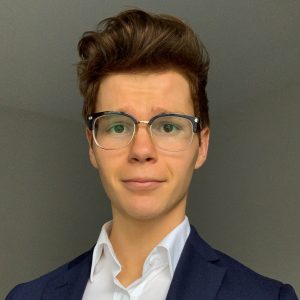Connor Mears

Material Layering for Impact Mitigation in Football Helmets
View Connor's project online
This award is generously sponsored by John H. Livingstone, SBM ’49.
Inherent to the game of football is collision. In a sport where some of the fastest, strongest athletes in the world are colliding constantly, there will always be risk for traumatic brain injury; no helmet can or will change this. However, could a helmet designed with an increased emphasis on energy dissipation, rather than peak force reduction, help to mitigate this inherent risk for concussion? Medical literature on the subject seems to indicate just that. Thus, helmet manufacturers and researchers alike have begun to recognize the importance of impact mitigation—that is, the dissipation of the pressure and impulse of a collision—in helmet design. In this paper, we consider three unique methods of material layering and then analyze their effectiveness in impact mitigation.
Our first design involves the use of polymers that exhibit high impedance mismatch to tune the frequency of the pressure waves of a collision to the critical frequency of a dissipative viscoelastic layer. Next, we consider a design that relies on a deformable outer shell composed of a thermoplastic elastomer that overlays columns that can bend and compress omnidirectionally in order to dissipate energy. Lastly, we study an approach based around an open-cell foam impregnated with a non-Newtonian silica-based suspension.
In each case, the primary point of analysis is the layering’s effectiveness in pressure and impulse dissipation. However, considerations of cost, ease of manufacturing, and current stage of development are also considered. Ultimately, we use this analysis to draw a conclusion as to the most effective method of material layering for impact mitigation.
What is your major and expected year of graduation?
Mechanical engineering, May 2022
What inspired you to pursue your project?
Like so many who are fortunate enough to grow up in the Greater Philadelphia Area, I was raised to eat, breathe, and sleep Eagles football. In recent years, however, there has been a growing body of evidence to suggest a link between playing football and developing chronic traumatic encephalopathy (CTE), a neurodegenerative condition that is caused by repetitive head trauma. While most helmets on the market today are effective in reducing the peak force of an impact, they do not actually dissipate the energy of the collision—a factor medical professionals agree is key in preventing traumatic brain injury. Thus, I was inspired to research how materials could be layered so as to not only reduce the peak force of a collision, but also to absorb the impulse, in hopes of finding a solution to protect players and the future of the game so many of us love.
What does winning this award mean to you?
To be awarded the Livingstone Undergraduate Research Award in STEM is a tremendous honor. While the research itself was completed last semester, this project is truly a culmination of a lifetime’s worth of support I have received from teachers, friends, and family. In particular, I would like to thank my project mentor, Professor Joe Danowsky, as well as my first teachers of all, Mom and Dad. Without your tireless love and support over the years, this would not have been possible. Thank you.
How did the Libraries support your work?
Temple Libraries played an instrumental role in my research process. With the help of Engineering Librarian Gretchen Sneff, I was able to find specialized resources on topics from the mechanics of traumatic brain injury to impact frequency tuning. Access to the library’s easy-to-navigate collection of reliable academic resources made the research process more pleasurable, efficient, and effective.
Connor attributes his interest in improving football helmets to his own youthful experience of multiple concussions from football and rugby. It “bothered” him that most helmets were still being optimized solely to prevent skull fractures rather than concussions. That concern turned into a focused research interest when our class browsed the open-stack bookshelves in the Charles Library. Engineering books on a wide range of topics looked interesting, but what clicked was “a materials science book with a section on protective applications of material layering.” That immediately triggered his interest in football helmets, and the result was this well-researched paper.
—Joseph Danowsky, Coordinator of Technical Communication course sections for the College of Engineering